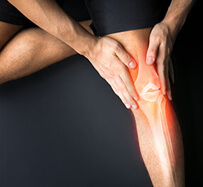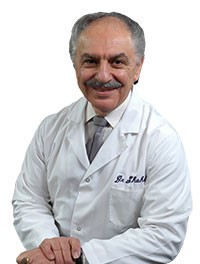Torn ACL Stem Cell Treatment in Wyckoff, NJ

Does your knee ache and swell up after vigorous physical activity? Have you been hearing a popping or crunching sound followed by pain or knee weakness? You may be suffering from a torn ACL, a common injury among physically active people and sports enthusiasts.
Regenerative medicine specialists have been performing stem cell therapies on professional athletes for over 20 years. When live stem cells are injected into damaged ligament tissue, they can stimulate your cells to repair and restore your torn ACL, relieving or reducing pain while promoting the growth of new cells in your knee tissue.
A torn ACL can be very painful and debilitating, but stem cell therapy may help you return to the work pace and leisure activities that have been curtailed by your injury. To speak with a stem cell injection specialist in Wyckoff today, call (201) 806-6099 or contact Dr. M. T. Shahab online.
What are the symptoms of a torn ACL?
The signs and symptoms are fairly straightforward:
- a loud popping sound or popping sensation in your knee
- severe knee pain and inability to walk or stand without pain
- swelling that starts within a few hours
- limited or lost range of motion
- feeling of knee weakness when weight is applied
People who experience ACL injury are more likely to develop knee osteoarthritis, a condition that deteriorates joint cartilage and makes its smooth surface rougher. Even if you have reconstructive surgery on your ligament, arthritis may still develop.
The severity of your original injury, related knee injuries, and your level of post-injury activity may influence the incidence of arthritis.
What causes an ACL to tear?
Your ACL is the anterior cruciate ligament—one of the major ligaments in your knee. It gives your knee rotational stability and mobility. Sudden stops, jumps, or direction changes, like those often executed in basketball, soccer, football, tennis, and gymnastics can damage it, causing a partial or complete tear. Mild knee injury may overextend your ACL but not tear it.
How is a torn ACL diagnosed?
Your healthcare provider will first perform a physical exam, checking your knee for swelling and tenderness, and moving it into different positions to assess range of motion and overall function.
A physical exam often suffices to make a diagnosis, but your provider may also recommend the following tests to rule out other physical causes or to determine your injury’s severity:
- X-ray: can show bone fractures, but cannot provide images of damaged soft tissues like ligaments and tendons
- MRI (magnetic resonance imaging): radio waves and a magnetic field create images of your tissues, showing the extent of your ACL injury and other damaged knee tissues
- Ultrasound: sound waves create images of your body’s internal structures, including soft tissues like ligaments, tendons, and muscles
How can stem cells treat a torn ACL?
Traditionally, knee replacement surgery and other invasive procedures have been the leading methods of treating a torn ACL, offering mixed results. For over 20 years, clinical trials have been demonstrating promising results of stem cell injections as an efficacious ACL and knee tissue treatment.
An ACL tear may be treated by injecting 5 million live-nucleated cells into your injured knee tissue. Live-nucleated cells, including mesenchymal stem cells, are harvested from an umbilical cord shortly after a mother gives birth. The umbilical cord is the leading source of viable mesenchymal stem cells.
When your provider injects stem cells into an area near injured tissue, they may inhibit damaging inflammation and regulate your immune system. At the same time, mononucleated cells produce growth factors that increase vasculature, repair damaged cells, and stimulate tissue regeneration with growth factors, proteins, and cytokines.
Are umbilical cord stem cells FDA approved?
The FDA recently confirmed there is only one registered and approved stem cell product on the market: umbilical cord blood-derived hematopoietic progenitor cells (blood forming stem cells) used for certain indications. While there is enormous promise in stem cell therapies, and thousands of ongoing experiments trying to establish efficacy, stem cell treatments do not yet meet the FDA’s scientific approval standard.
Practitioners tapping into this enormous promise of stem cells for any therapeutic use must exercise their professional judgment and expertise. We urge anyone embarking on the use of stem cell therapies to consult the national health data bases to evaluate current clinical trial information, and the FDA’s website on human tissue to get its current therapy evaluations.
In 2018 the FDA’s commissioner and research director reported that the agency will be incorporating some “new concepts for how small investigators and firms can seek and meet the approval standard for products through efficient expedited pathways.” You can keep up with latest developments on the FDA’s website.
What are the side effects of stem cell injections?
Most patients tolerate stem cell injections well, with few or no side effects. However, all medical procedures present the possibility of side effects. Most commonly reported are slight pain or soreness near the injection site. As with any other injection procedure, there is a small risk of bacterial infection NOT associated with the cellular product.
Discuss your medical history, expectations, and any medications you’re currently taking with your doctor. While most people are good candidates for stem cell injections, certain medical conditions may interact with stem cell therapy.
If you experience any severe or prolonged side effects, don’t wait—contact your healthcare provider or seek emergency medical attention right away.
Where do these live stem cells come from?
We process the umbilical cord blood of healthy newborns. If a pregnant woman scheduled for caesarean section decides she does not want to keep and store her unborn child’s umbilical cord, her OB/GYN asks whether she would like to donate it. After signing an informed consent form, a medical and social history review is conducted, as well as a blood test.
If the new mother meets all donor eligibility requirements, she is accepted as a donor. After her baby is born, the umbilical cord blood is collected in a sterile collection bag and sent to a lab.
The cord blood is processed within 48 hours using proprietary methods. A sample of the finished product is tested by an independent third-party lab for sterility. Only after all lab reports have passed the regulatory requirements can the umbilical cord stem cells be distributed.
Is stem cell therapy safe?
Stem cell products have the potential to treat a vast number of medical conditions. They’re already becoming a common alternative to risky, expensive surgeries in orthopedics, especially sports medicine, which has been treating athletes with regenerative therapies for over 20 years. However, the science demonstrating the benefits and safety behind each of these products is still in developmental stages.
That being said, thousands of studies around the world have demonstrated positive outcomes of stem cell use and show that stem cells derived from umbilical cord are able to regulate our immune system more effectively than stem cells derived from bone marrow or fat.
Before embarking on any stem cell therapy, you should consult the clinical trials on the national health databases and always seek the advice of your healthcare provider.
Are umbilical cord stem cells FDA approved?
The FDA recently confirmed there is only one registered and approved stem cell product on the market: umbilical cord blood-derived hematopoietic progenitor cells (blood forming stem cells) used for certain indications. While there is enormous promise in stem cell therapies, and thousands of ongoing experiments trying to establish efficacy, stem cell treatments do not yet meet the FDA’s scientific approval standard.
Practitioners tapping into this enormous promise of stem cells for any therapeutic use must exercise their professional judgment and expertise. We urge anyone embarking on the use of stem cell therapies to consult the national health data bases to evaluate current clinical trial information, and the FDA’s website on human tissue, to get its current therapy evaluations.
In 2018 the FDA’s commissioner and research director reported that the agency will be incorporating some “new concepts for how small investigators and firms can seek and meet the approval standard for products through efficient expedited pathways.” You can keep up with latest developments on the FDA’s website.
How many cells does it take to treat my tissue damage?
Worldwide clinical research and experience over almost 20 years has given us some effective parameters for various types of injury. After examining and assessing the nature and severity of your injury, medical history, and general health, your provider will decide how many million cells are needed for fast, effective treatment.
Is it normal to have an inflammatory response after my Injection?
It is not uncommon to have an inflammatory response after a stem cell injection. This is not because your body is rejecting the cells. It may actually be a positive sign that the live cells are creating a healing response.
The degree of inflammatory response to our live-nucleated cells can vary based on:
- the levels of IL-6 within your joint or tissue
- the severity of damage and current inflammation in your joint
- PRP therapy in conjunction with stem cell injection increases the probability of an inflammatory response
What are the risks or side effects of stem cell injections?
As with any other injection procedure, there is a small risk of bacterial infection not associated with the injected cells. If you experience severe pain, bleeding, or swelling at your injection site, or if you experience fever, nausea, dizziness, vomiting, or any other concerning symptoms, don’t wait—call your medical provider or seek emergency medical care right away.
Will I be given an anesthetic?
You may be given a small amount of local anesthetic to numb the needle pathway on your skin. However, your provider will not apply large amounts of local anesthetic into the area being treated. Studies have shown that doing so may damage the nucleated cells.
How long does it take to get relief?
Pain relief typically begins immediately after your treatment. Regeneration time varies depending on the severity of your injury and your ability to follow post treatment care, along with your rehabilitation program to strengthen affected areas.
Reserve your appointment today
A torn ACL can cause intense pain, limiting your ability to walk, work, and enjoy the best things in life. Stem cell injection therapy may be able to help repair your ACL, reduce or eliminate your pain, and improve your quality of life. To speak with a stem cell injection specialist in Wyckoff today, call (201) 806-6099 or contact Dr. M. T. Shahab online.
MedWell Non Surgical Orthopedic Stem Cell & Regenerative Therapy Center
Address
33 Central AvenueMidland Park, NJ 07432
(201) 806-6099
www.BergenCountyDoctors.com
Hours
Mon:
8:00 am - 6:30 pm
Tue:
2:00 pm - 6:30 pm
Wed:
8:00 am - 6:30 pm
Thu:
9:00 am - 1:00 pm
Fri:
8:00 am - 6:30 pm
Sat:
9:00 am - 1:00 pm
Sun:
By Appointment Only




